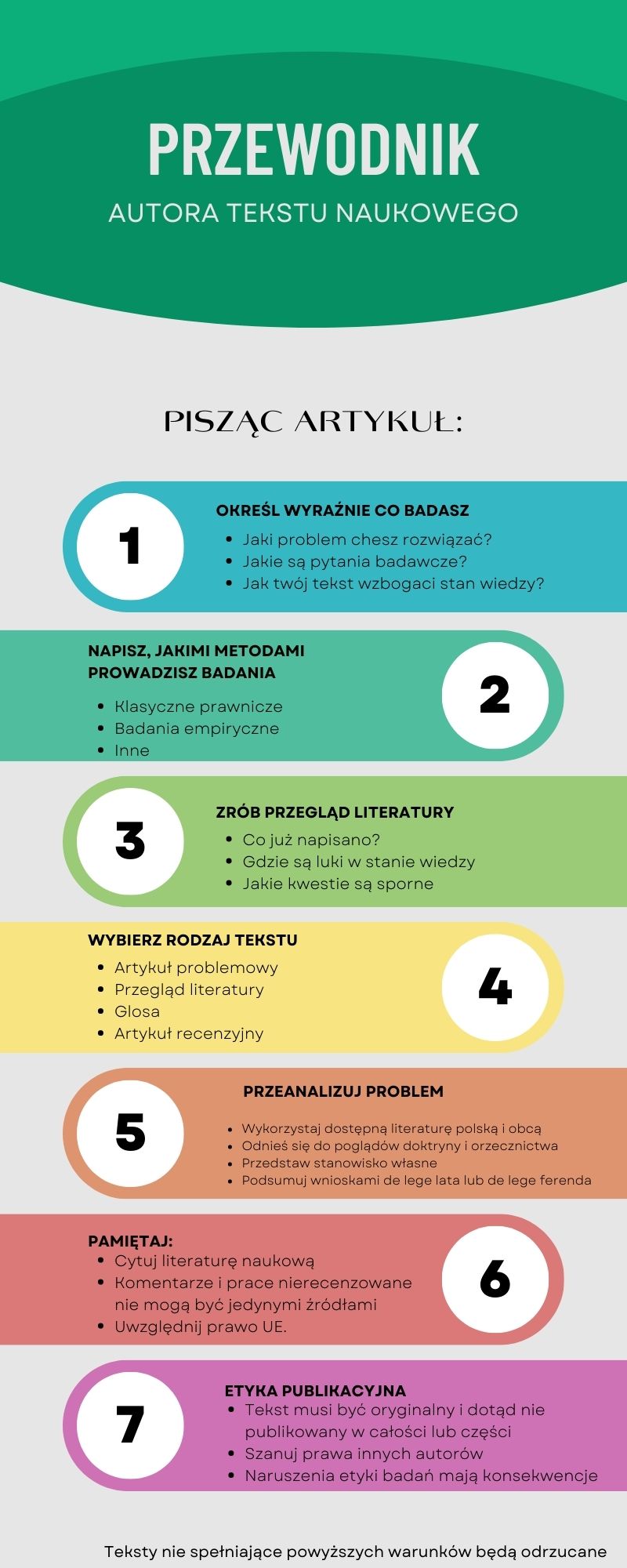


ZAŁOŻENIA OGÓLNE
Dwie wersje artykułu (zawierający dane Autora oraz artykuł zanonimizowany) wraz z oświadczeniami (oświadczenie autora oraz oświadczenie etyczne) należy wprowadzić na Platformie Czasopism Uniwersytetu Opolskiego w zakładce: zgłoś tekst. W przypadku doktorantów wymagamy pozytywnej opinii promotora pracy doktorskiej, dołączonej przy zgłaszaniu tekstu.
Artykuł należy przygotować korzystając z gotowego szablonu. W czasopiśmie obowiązują przypisy nawiasowe i styl bibliograficzny Chicago. Redakcja dopuszcza stosowanie przypisów dolnych o charakterze polemicznym.
Czas procedowania w czasopiśmie wynosi do 5 miesięcy.
KOLEJNOŚĆ POSZCZEGÓLNYCH CZĘŚCI SKŁADOWYCH
PARAMETRY TEKSTU ZASADNICZEGO
Streszczenie powinno być zwięzłe (od 100 do 300 słów) i mieć określoną strukturę:
Cechy streszczenia:
Słowa kluczowe:
SPOSÓB OPRACOWANIA BIBLIOGRAFII
AKTY PRAWNE
Ustawa z dnia 25 lutego 1964 r. – Kodeks rodzinny i opiekuńczy. Dz.U. 2015, poz. 2082, tekst jednolity.
Ustawa z dnia 29 maja 1995 r. o zmianie ustawy – Kodeks rodzinny oraz niektórych innych ustaw. Dz.U. Nr 83, poz. 417.
Ustawa z dnia 5 grudnia 2008 roku o zapobieganiu oraz zwalczaniu zakażeń i chorób zakaźnych u ludzi. Dz.U. 2020, poz. 1845, tekst jednolity.
ORZECZNICTWO
Postanowienie SN z dnia 6 grudnia 2007 r., IV CKS 274/07. Dostęp: 01.12.2018. LEX nr 349935.
Uchwała składu 7 sędziów SN z dnia 30 listopada 1994 r., III CZP 99/94. Dostęp: 21.04.2018. LEX nr 4138.
ARCHIWALIA
IPN Bu, sygn. akt 1283/687/J, odpis doniesienia przyjaciel „Nowak” dot. Konferencji Plenarnej w Niemczy w dniu 9 grudnia 1947 r. z dnia 10 grudnia 1947 r., k. 49.
MONOGRAFIA
Grazer, Brian, and Charles Fishman. 2015. A Curious Mind: The Secret to a Bigger Life. New York: Simon & Schuster.
Rose-Ackerman, Susan. 2001. Korupcja i rządy. Warszawa: Fundacja im. Stefana Batorego.
MONOGRAFIA WYDANA W SERII
Kantor-Pietraga, Iwona. 2007. Zróżnicowanie przestrzenne struktur ludnościowych w miastach
województwa katowickiego w latach 1978–1988. Prace Naukowe Uniwersytetu Śląskiego, 2461. Katowice: Wydawnictwo Uniwersytetu Śląskiego.
ARTYKUŁ W CZASOPIŚMIE Z PODANIEM PEŁNEGO ZAKRESU STRON I NUMEREM DOI (jeśli został nadany)
Keng, Shao-Hsun, Chun-Hung Lin, and Peter F. Orazem. 2017. Expanding College Access in Taiwan, 1978–2014: Effects on Graduate Quality and Income Inequality. Journal of Human Capital 11(1), 1–34. https://doi.org/10.1086/690235
Klein, Edmund. 1969. Wybory do konstytuanty niemieckiej w styczniu 1919 r. na Górnym Śląsku. Studia Śląskie, 14(2), 15–26.
PRACA ZBIOROWA
Kobylińska, Aleksandra, Grzegorz Makowski i Marek Solon-Lipiński (red.). 2012. Mechanizmy przeciwdziałania korupcji w Polsce. Raport z monitoringu. Warszawa: Instytut Spraw Publicznych.
ROZDZIAŁ W PRACY ZBIOROWEJ Z PODANIEM PEŁNEGO ZAKRESU STRON
Machel, Henryk. 2007. Oddziaływanie programowane – oczekiwania i rzeczywistość. W: Więziennictwo na początku XXI wieku. III Polski Kongres Penitencjarny, (red.). Teodor Bulenda, Wojciech Knap, Zbigniew Lasocik, 247–256. Warszawa: Instytut Profilaktyki Społecznej i Resocjalizacji Uniwersytetu Warszawskiego.
Thoreau, Henry David. 2016. Walking. W: The Making of the American Essay, (red.) John D’Agata, 167–95. Minneapolis: Graywolf Press.
E-BOOK
Borel, Brooke. 2016. The Chicago Guide to Fact-Checking. Chicago: University of Chicago Press. ProQuest Ebrary. https://press.uchicago.edu/ucp/books/book/chicago/C/bo21182584.html
CZĘŚĆ JEDNEGO AUTORSTWA W KOMENTARZU WIELOAUTORSKIM
Górski, Marek. 2019. W: Prawo ochrony środowiska. Komentarz. 3. wydanie. Marek Górski, Marcin Pchałek, Wojciech Radecki, Jan Jerzmański, Magdalena Bar, Sergiusz Urban, Jerzy Jendrośka, 15-27. Warszawa: C.H.BECK.
KOMENTARZ AUTORA DO ARTYKUŁU W KOMENTARZU POD REDAKCJĄ W WERSJI ELEKTRONICZNEJ
Wegner, Joanna. 2019. Komentarz do art. 50. W: Kodeks postępowania administracyjnego. Komentarz, (red.) Wojciech Chróścielewski, Zbigniew Kmieciak, Warszawa: Wolters Kluwer, wydanie elektroniczne LEX, Dostęp:16.11.2020.
KOMENTARZ JEDNEGO AUTORSTWA
Wojciechowska, Karolina Barbara. 2019. Ustawa o transporcie drogowym. Komentarz. Warszawa: C.H.BECK
ŹRÓDŁA INTERNETOWE
Raport Agencji Bezpieczeństwa Wewnętrznego. Korupcja w Polsce – próba analizy zjawiska. Antykorupcja. Edukacyjny Portal o Antykorupcji. Dostęp: 01.04.2018. www.antykorupcja.gov.pl/download/4/5356/RaportAgencjiBezpieczenstwaWewnetrznegoKorupcjawPolsce-probaanalizyzjawiska.pdf.